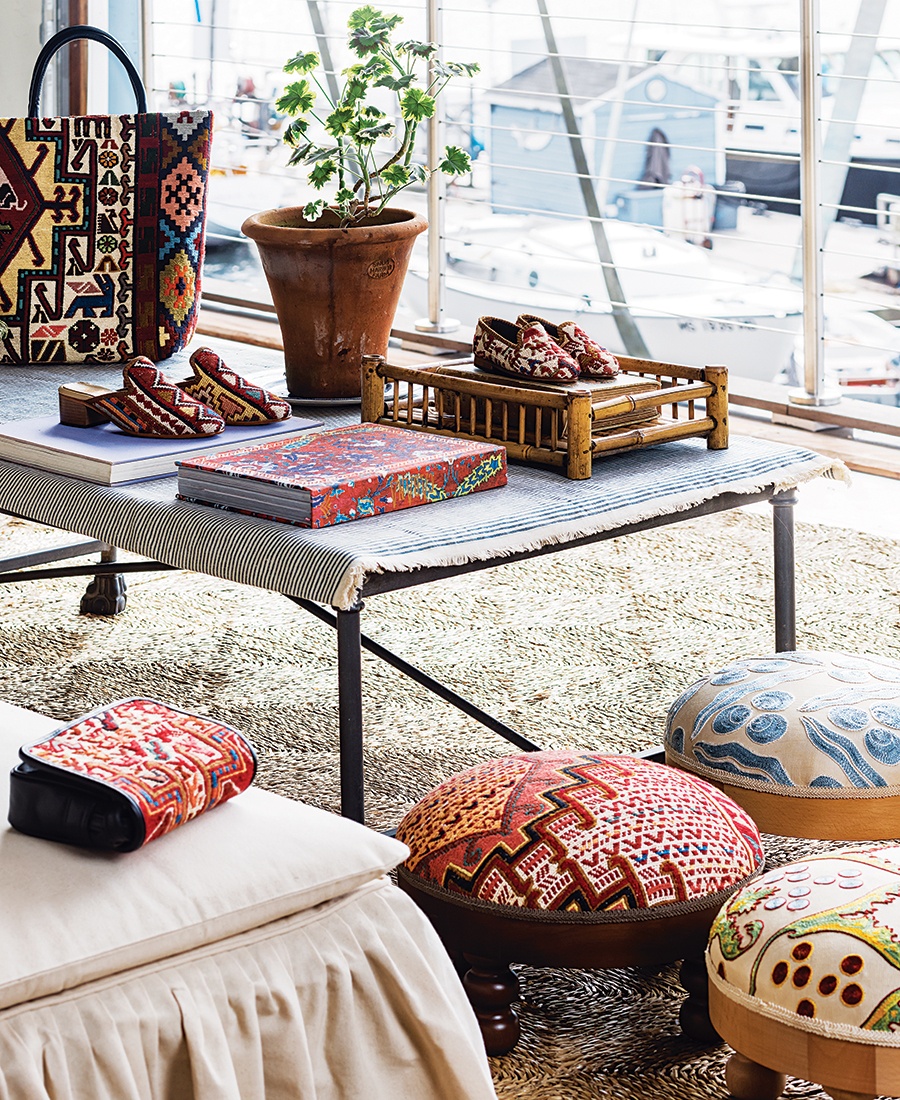Milicent Armstrong’s Artisan Journey from Turkey to Marblehead
Artemis Design Co. marries Turkish textiles with American style.

Photo by Joyelle West
This article is from the winter 2025 issue of Boston Home. Sign up here to receive a subscription.
When Milton native and Marblehead resident Milicent Armstrong was a kid, she would knit scarves, blend perfume, and make blueberry jam that she’d sell to family each Thanksgiving. As part of a creative, entrepreneurial family, she says she was excited to carry on that artistic spirit in her own way.
And she still does. Armstrong was an interior design student at Boston Architectural College when she founded Artemis Design Co. from her South End apartment in 2013. Inspired by a semester-at-sea visit to Istanbul, Turkey, she returned to the city’s small artisan workshops to curate one-of-a-kind shoes and handbags from rare, vintage kilim rugs. Belts, pillows, and footstools followed in the past decade, and she recently expanded to a new by-appointment retail space in Marblehead, where her vision for a refined lifestyle brand will launch her designs far beyond the dinner table.

Armstrong recently launched Artemis’s flagship retail space in Marblehead, which will be an appointment-only haven for Middle Eastern–inspired footwear, bags, and home goods. / Photo by Joyelle West
“In Turkey, I saw products that were made out of kilim. I was so smitten by the beauty of it—and of Istanbul, the bazaars and textiles—I just fell in love with it,” she recalls. “There’s something about the tangible quality of goods and beauty that I’m really attracted to. So I create products that I love and that charm and delight me so that we can charm and delight our customers.”
Women artisans have woven these thin, tapestry-style carpets since the ancient Persian Empire, incorporating stories or struggles from their lives with geometric symbols like the all-seeing eye to ward off evil or a bird in flight to represent good news. Reflecting the mood and wishes of the women means kilims are not meaningless patterns, Armstrong explains, and this imbues her products with a deeper purpose.

“From a practical standpoint, kilim is an incredibly comfortable material. That’s one of the things I noticed. It molds to your foot almost better than leather. So comfort wise, the way it’s woven with breathable wool material, it literally just forms to your foot, and they feel like slippers,” founder Milicent Armstrong says. “And then there’s the beauty of it. They’re asymmetrical, which is cool, so you can’t even find a single pair of our shoes that are exactly symmetrical one side to another.” / Photo by Joyelle West
Because, she says, “it would be sacrilege to cut up a perfectly good rug to make a pair of shoes,” Armstrong salvages reams of gorgeous wool designs from used carpets that have minor damage, like a small stain or rip. She highlights smaller patterns for women’s and men’s kilim loafers or a larger pattern for a satchel or footstool that gives the pattern the right amount of space. One rug creates 10 to 20 pairs of shoes, and because each rug is slightly different, no two shoes or bags are exactly the same. “The patterns and colors are incredibly beautiful,” Armstrong says, “and the history and story behind the kilim is so rich.”

Photo by Joyelle West
An Artemis box arrives in the mail with the kilim’s history and the life cycle of these “magic carpets” explained in an enchanting booklet, complete with an illustrated poem and a guide to reading kilim symbols. Armstrong says it’s important to share this story so customers can understand the true value of their new purchase. A custom dust bag and shoehorn arrive, too, along with care and sizing instructions to foster a lifetime of appreciation. “I wanted this to be something that was for every day, comfortable, and easy to wear,” she says. “We’re giving this beautiful work of kilim art a whole other life.”
Armstrong hopes to expand the lifestyle aspect of the business by adding antiques to her repertoire while focusing on the iterative process of craftsmanship, authenticity, and customer experience.
“One of the things that makes our products special is that you don’t see them all over the place,” she says. “We’re not trying to crank out a bunch of new products every single season. We’re trying to create things that will be evergreen and that we’ll keep in our permanent collection.”
First published in the print edition of Boston Home’s Winter 2025 issue, with the headline, “Magic Carpet Ride.”


